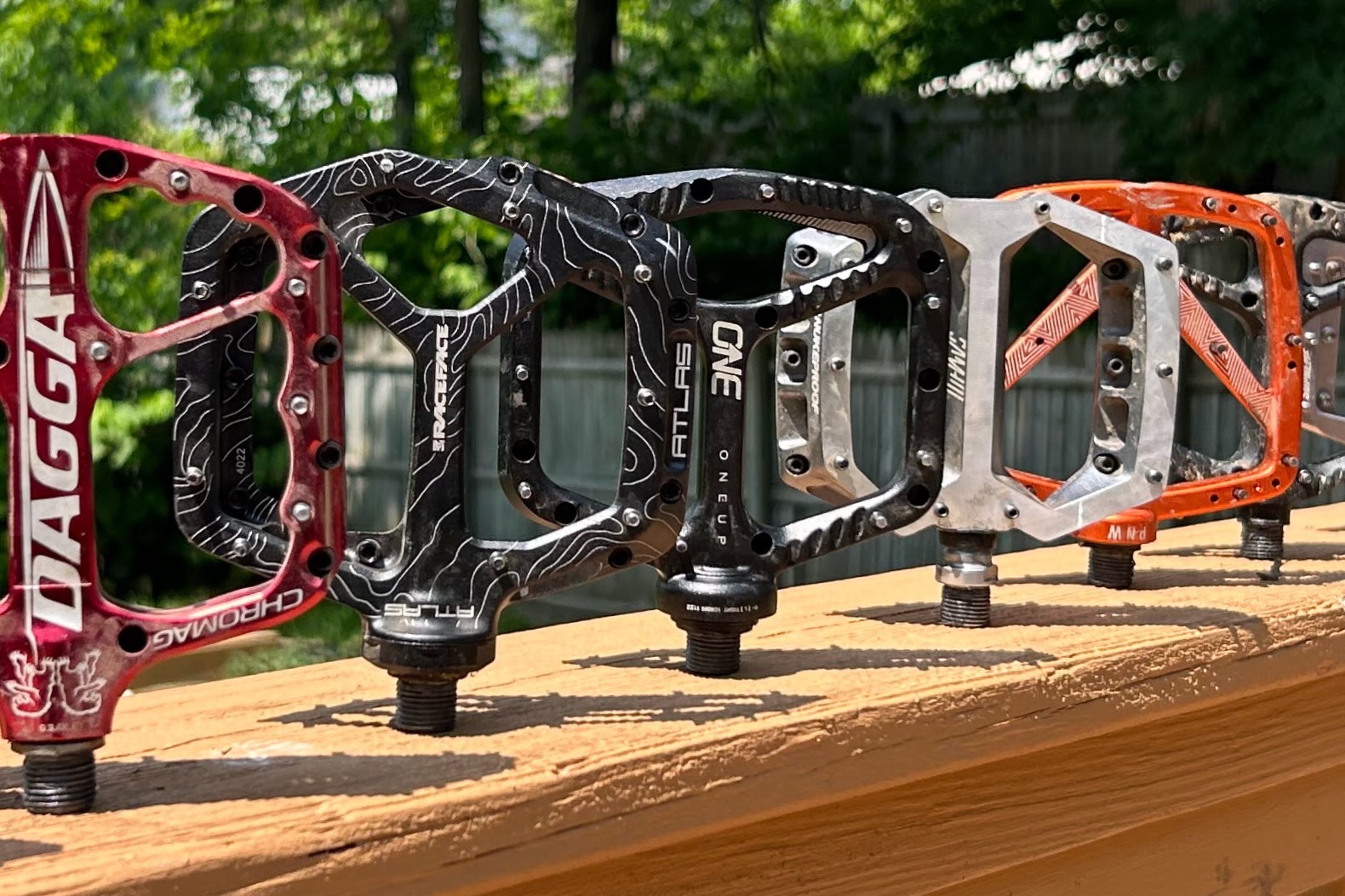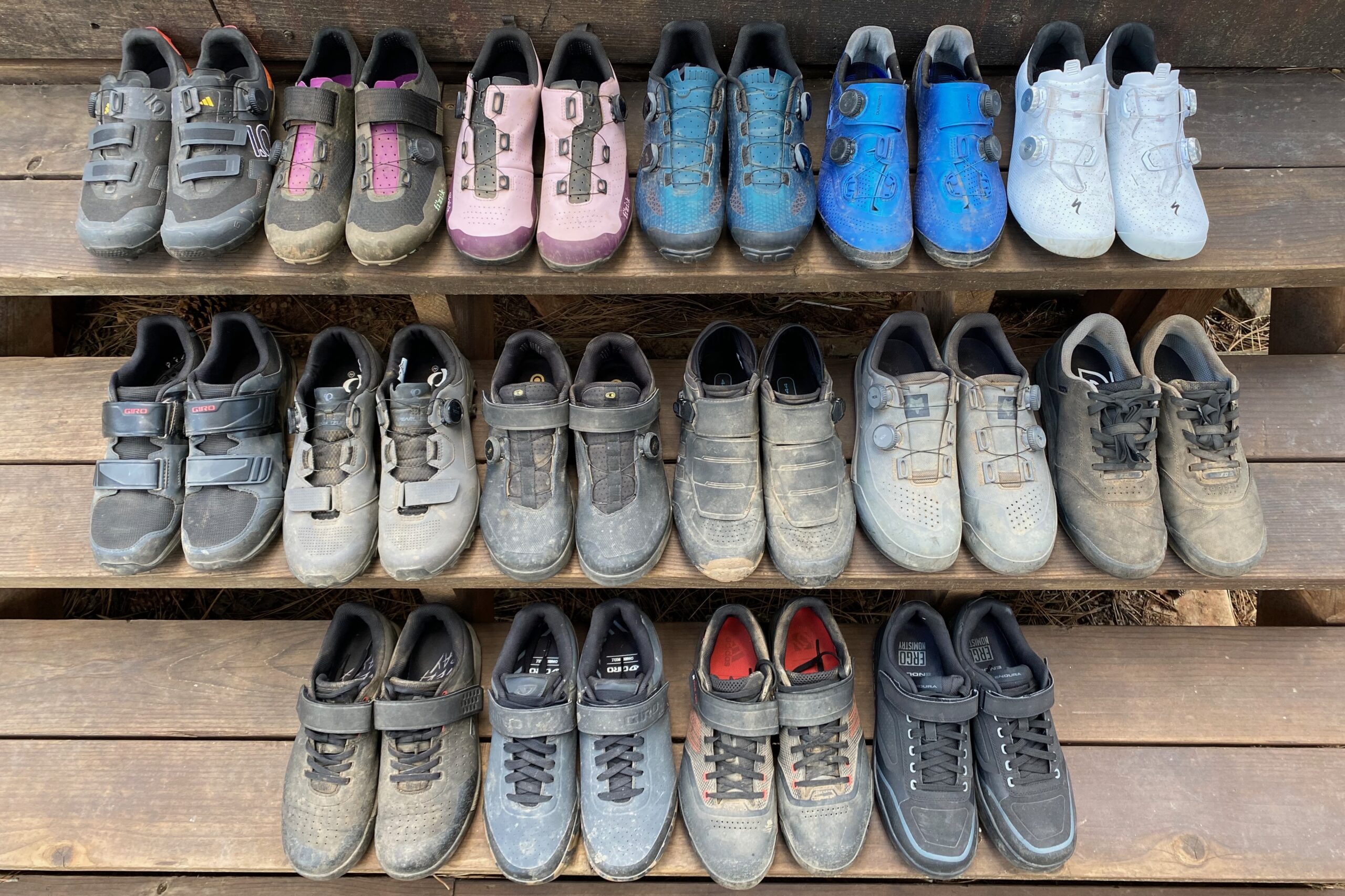The Best Flat Pedal Shoes of 2023
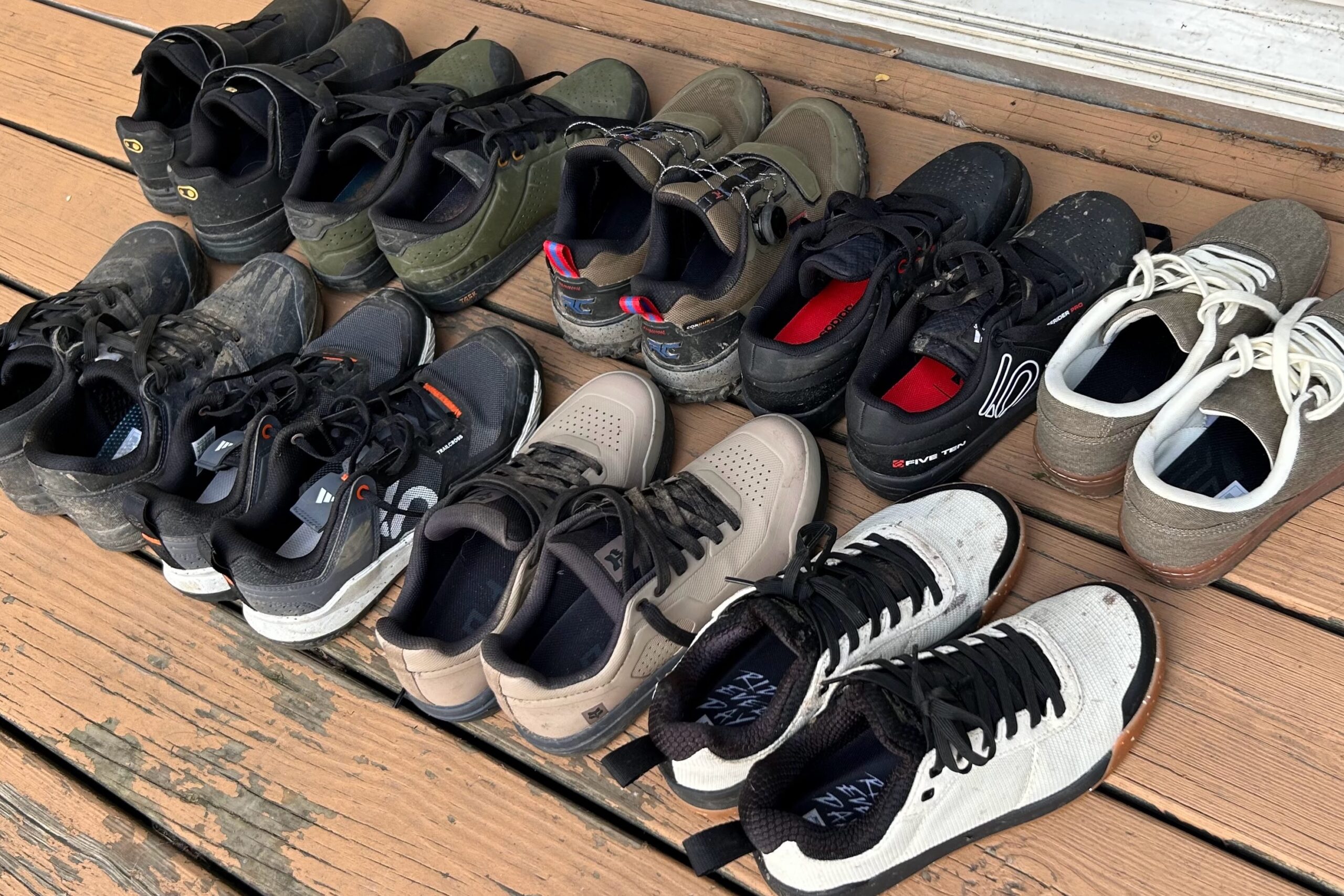
Your feet serve as an important contact point on your mountain bike and a good pair of flat pedal shoes provides grip, stability, comfort, and control. Serving as the important interface between our feet and our pedals, our shoes take some serious abuse and do lots of work, so finding the right pair can help enhance your experience and elevate your performance on the bike.
As mountain bikers, we demand a lot from our footwear. Flat pedal shoes should provide reliable traction on your pedals, a supportive platform, efficient power transfer, breathability, water resistance, foot protection, and all-day comfort. While our options used to be somewhat limited, nowadays, there is a wide variety of flat pedal specific mountain bike footwear designed to meet the needs of varying riding styles, weather conditions, and personal preferences. Whether you prioritize grip, support, pedal feel, versatility, or weather resistance, there’s a flat pedal shoe for you.
With so many options on the market, finding the right flat pedal shoes isn’t as straightforward as it used to be. To help, we gathered a diverse selection of 10 models and tested them for months while analyzing their design, fit, pedal grip, sole stiffness, pedaling efficiency, and overall feel on the pedals and when walking. When testing concluded, we zeroed in on our favorites and those that excel for specific reasons compared to the rest.
All of the shoes we tested are solid options, but our top recommendations are listed below, followed by the best of the rest which are all still worthy choices. To compare the models we tested at a glance, check out our comparison chart. If you need help deciding what to buy, take a look at our buying advice and our FAQ section for answers to common questions about mountain bike flat pedal shoes. If you’ve landed here and are interested in mountain bike shoes that clip in to your pedals, we’ve thoroughly tested and reviewed the best clipless mountain bike shoes too.
The Best Flat Pedal Shoes of 2023
- Best Overall Flat Pedal Shoes: Giro Latch
- Best Budget Flat Pedal Shoes: Ride Concepts Accomplice
- Runner-Up Best Flat Pedal Shoes: Five Ten Freerider Pro
- Best Flat Pedal Shes for Adventure Riding: Ride Concepts Tallac Boa
- Best Flat Pedal Shoes for Grip: Specialized 2FO DH Flat
- Best Waterproof Flat Pedal Shoes: Five Ten Trailcross GTX
- Best Casual Flat Pedal Shoes: Specialized 2FO Method
Giro Latch
Specs
- MSRP $150
- Measured Weight 603 grams (pair, size 7.5 US / 40 EU)
- Upper Materials Microfiber
- Outsole Tack Rubber
- Closure Laces with elastic lace retainer
- Size Tested US Mens 7.5 / 40 EU
- Available Sizes Whole: 39 – 50 EU (no half sizes)
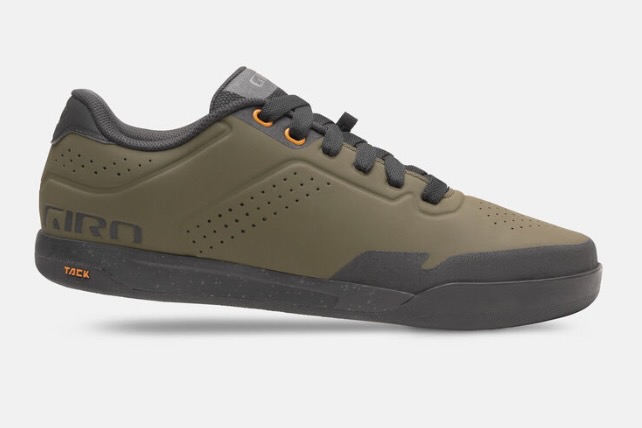
Pros
- Tack Rubber sole is supremely grippy, top of class
- Stiffer than average sole with controlled, predictable, and supportive flex
- Low stack height
- Excellent muted and predictable feel
- Average breathability and water resistance – dries quickly and easy to clean.
Cons
- Sole is a little stiff for long walks
- Average breathability and water resistance – jack of all trades, not purpose built for wet or super hot days.
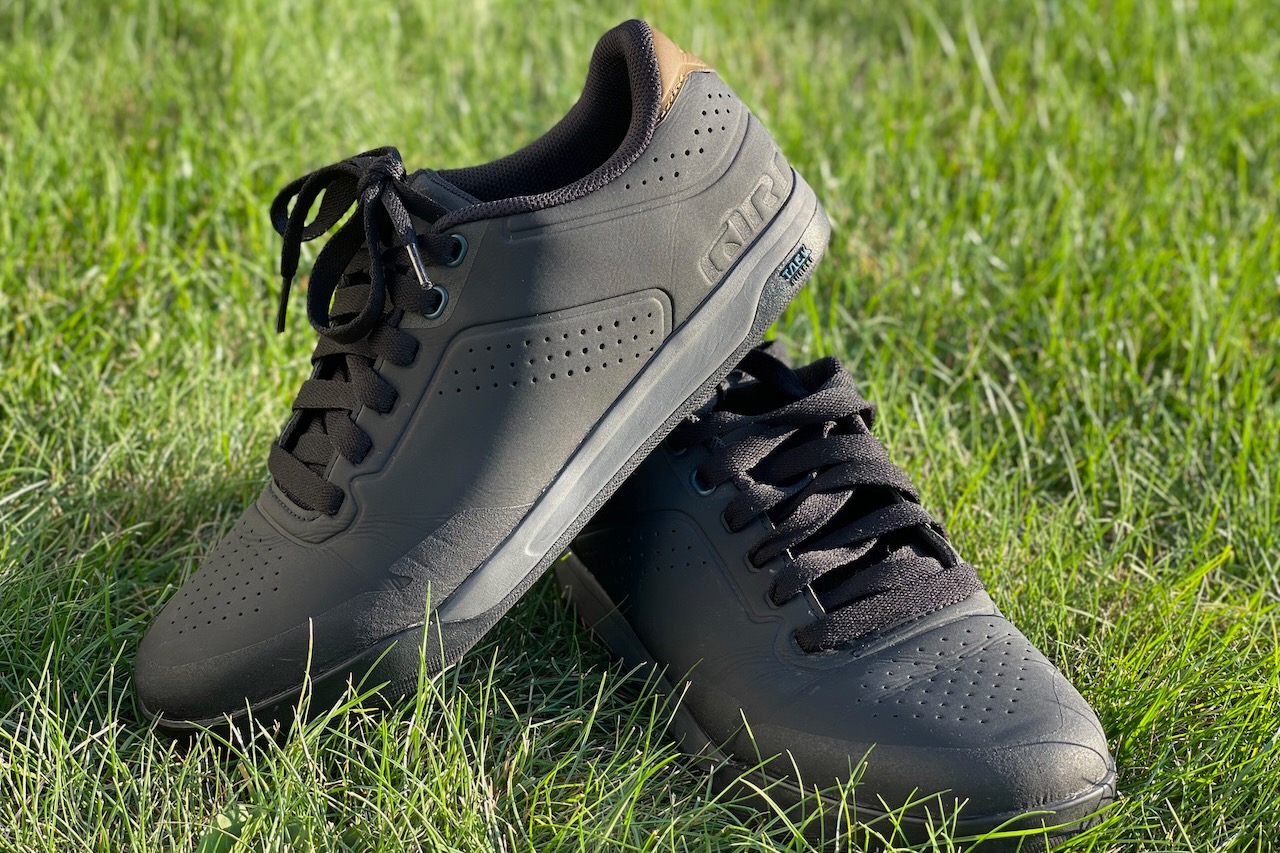
Ride Concepts Accomplice
Specs
- MSRP $130
- Measured Weight 643 grams (pair, size 7 US / 39.5 EU)
- Upper Material Nylon Upper with suede eye row detail,
- Outsole Ride Concepts MAX GRIP
- Closure Laces with elastic lace retainer
- Size Tested 7 US Mens / 39.5 EU
- Available Sizes Whole: 7 – 15 US, Half: 7.5 – 12.5 US
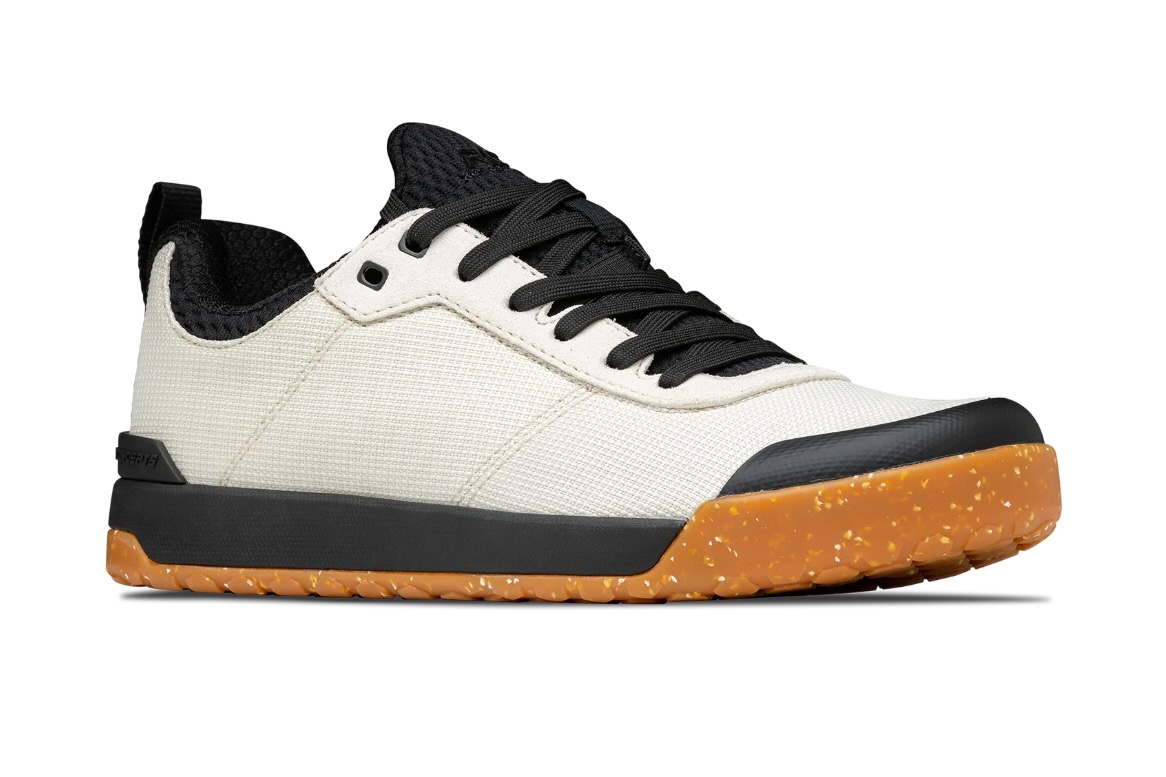
Pros
- Extremely comfortable
- Solid grip on the pedals
- Reasonable price point
- Good insole/arch support
Cons
- Warmer on the feet
- Not very weather or water resistant
- Woven nylon upper traps mud/dirt and gets quite dirty – not the easiest to clean
- Short height in toe box, but it did break in
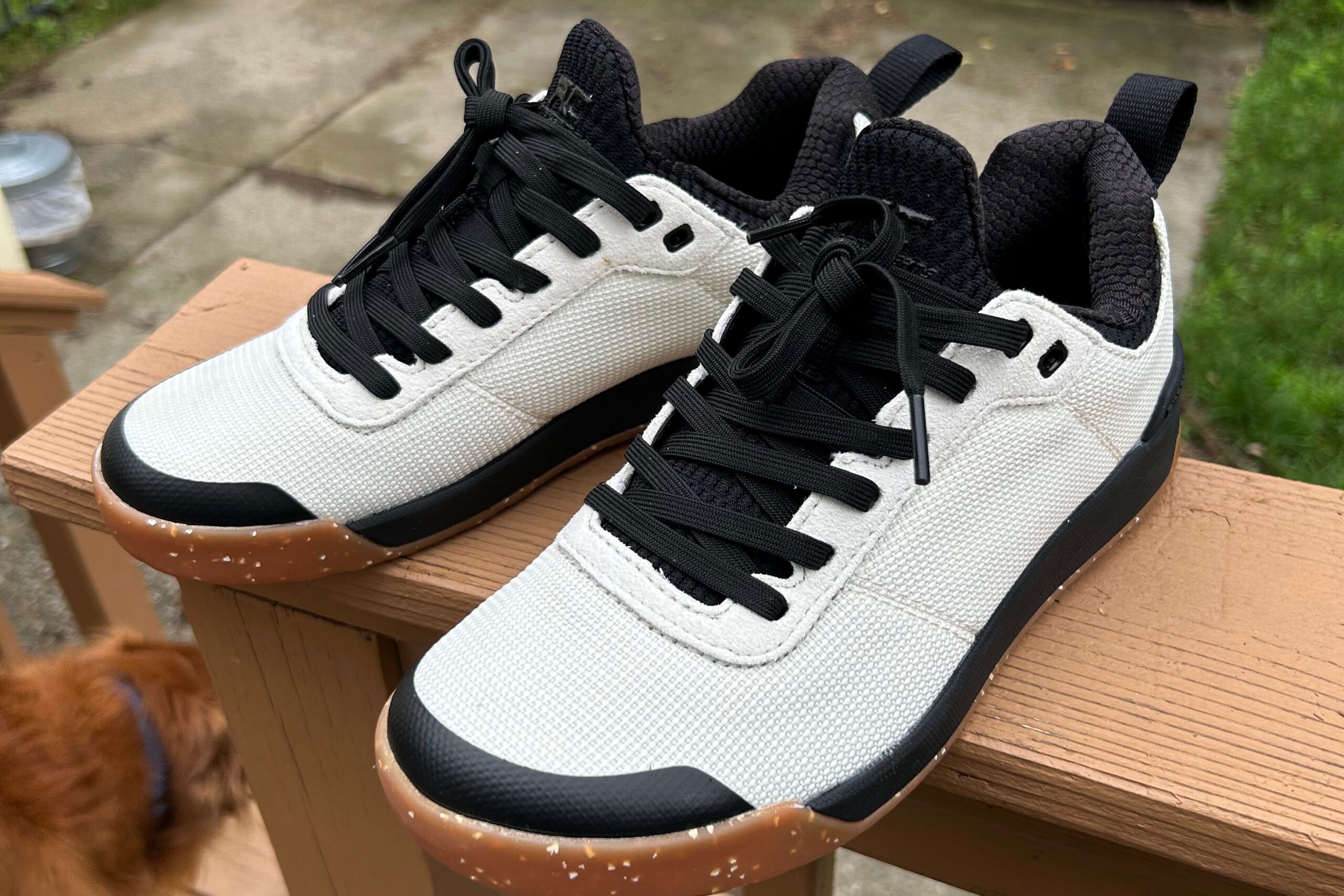
Five Ten Freerider Pro
Specs
- MSRP $160
- Measured Weight 627 grams (pair, size 7 US / 40 EU)
- Upper Materials Synthetic upper
- Outsole Stealth S1 Dotty rubber
- Closure Laces with elastic lace retainer
- Size Tested US Mens 7 / 40 EU
- Available Sizes Whole: 6 – 15 US, Half: 6.5 – 12.5 US
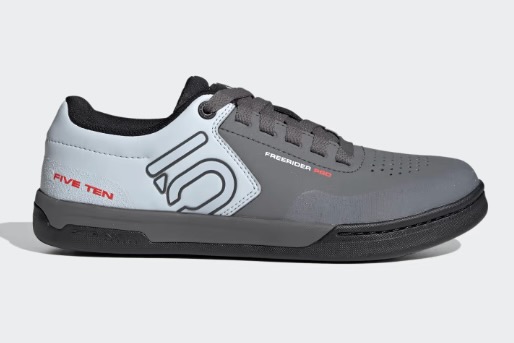
Pros
- Well deserved high reputation
- Outstanding traction
- Fair breathability and water resistance
- The benchmark for flat pedal shoes
- Versatile
Cons
- Lots of visible branding
- Sole may be too soft for some preferences
- Moderate pedaling efficiency
- Stealth rubber does wear quickly

Ride Concepts Tallac Boa
Specs
- MSRP $190
- Measured Weight 720 grams (pair, size 7 US / 39.5 EU)
- Upper Material Cordura
- Outsole Ride Concepts MAX GRIP
- Closure BOA, textile TX4 Laces, Velcro strap
- Size Tested 7 US Mens / 39.5 EU
- Available Sizes Whole and half sizes 7 – 13 US
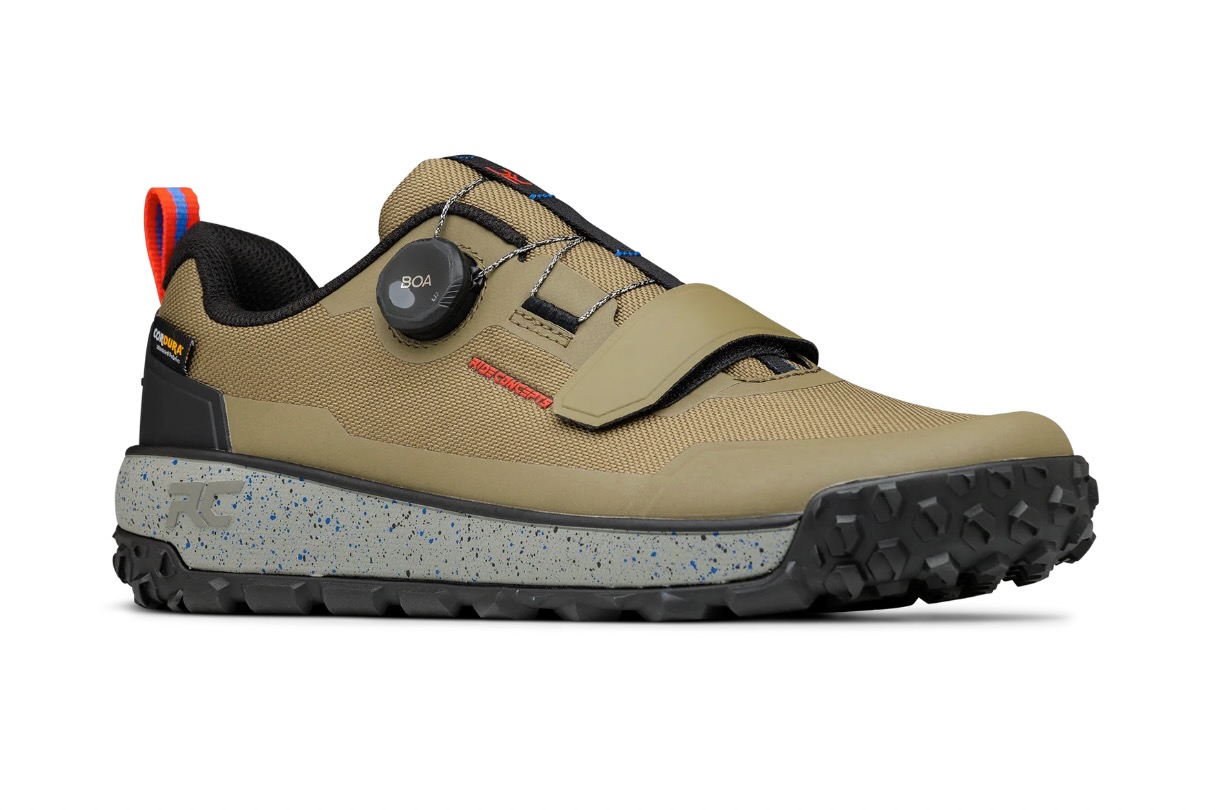
Pros
- Stiff sole
- Good pedaling efficiency
- Superb traction on and off the bike
- Very walkable
- Cordura upper breathes well and provides solid water resistance
- BOA closure is quick and easy to deal with, particularly in wet conditions
Cons
- Heavier weight
- Toe box is a little tight in height, but broke in over testing period
- Higher stack height may not be for everyone
- More expensive
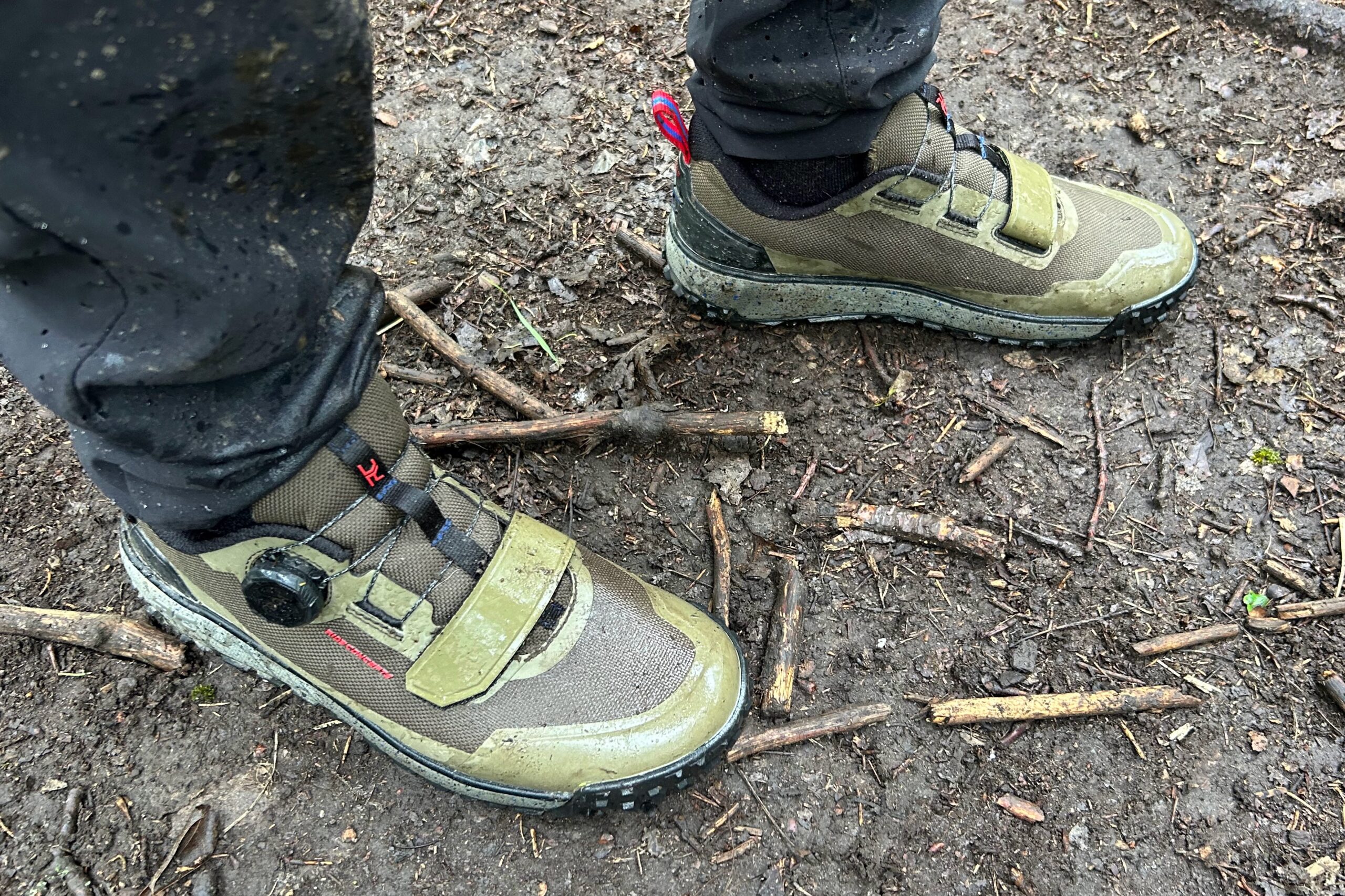
Specialized 2FO DH Flat
Specs
- MSRP $150
- Measured Weight 734 grams (pair, size 7.25 US / 39.5 EU)
- Upper Material Leather and textile upper
- Outsole SlipNot ST (Super Tacky)
- Closure Laces with elastic lace retainer
- Size Tested 7.25 US Mens / 39.5 EU
- Available Sizes Whole: 36 – 49 EU, Half: 38.5 – 46.5 EU
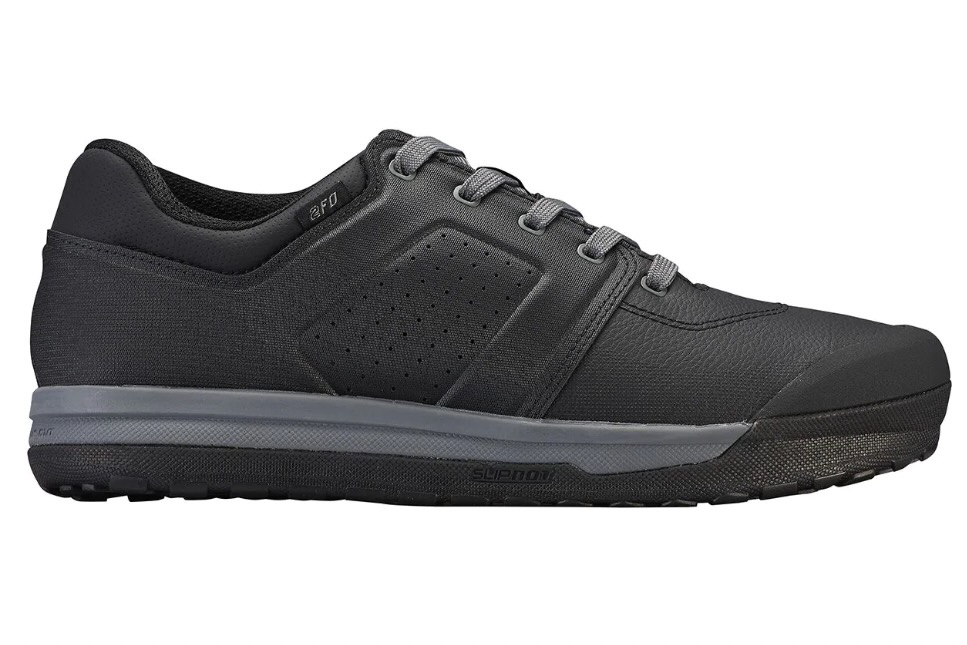
Pros
- Extremely high traction
- Body Geometry design provides a very comfortable feel on the pedals
- Great balance of water resistance and breathability
- Quick drying
- High level of foot protection
- Minimal Branding
Cons
- Might be too grippy for some, can be difficult to reposition feet
- Not the most comfortable walking shoe
- Narrower/more tapered toe box
Five Ten Trailcross GTX
Specs
- MSRP $220
- Measured Weight 692g (pair, size 5 US)
- Upper Materials Textile with neoprene collar and Gore-Tex membrane
- Outsole Stealth Dual Compound
- Closure Laces with neoprene ankle cuff
- Size Tested US Mens 5
- Available Sizes Whole: US Mens 4 – 15, Half: US Mens 4.5 – 12.5
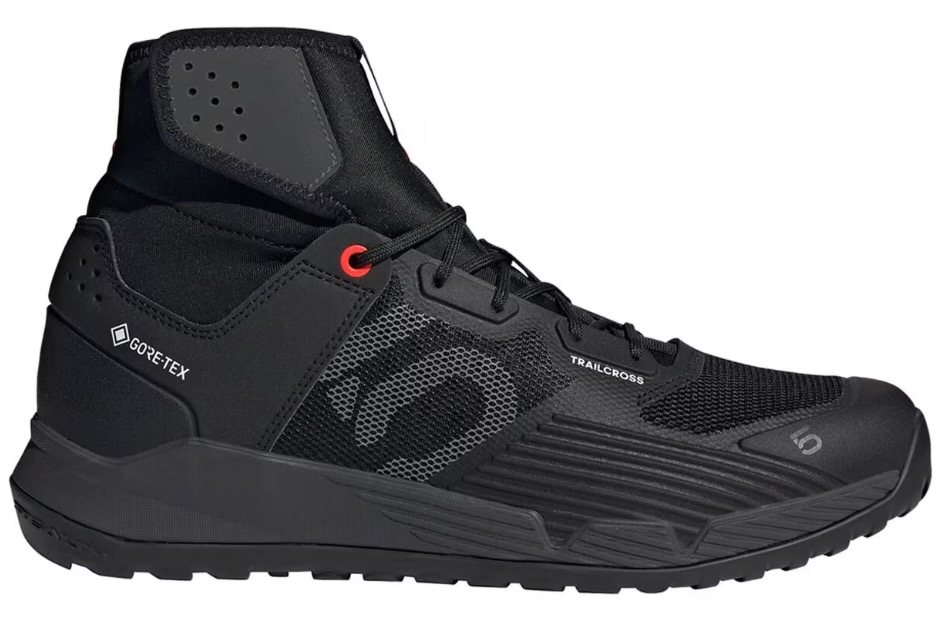
Pros
- Waterproof membrane
- Grippy on the pedals
- Easy to walk in
- Warmer than non-GTX version
Cons
- Expensive
- Water can still get in through the top if you're not careful
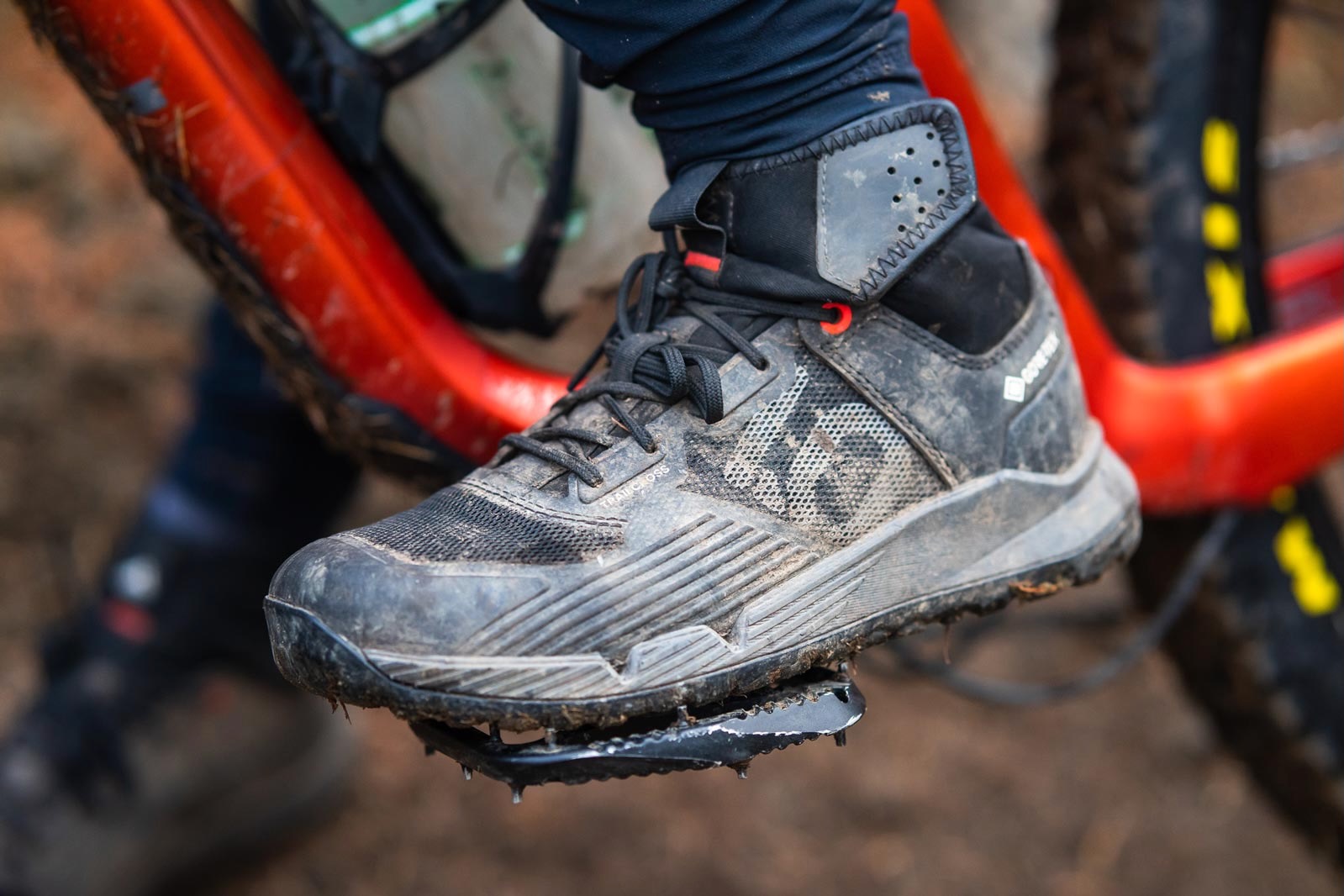
Specialized 2FO Method
Specs
- MSRP $100
- Measured Weight 540 grams (pair, size 7.25 US / 39.5 EU)
- Upper Material Canvas
- Outsole SlipNot ST (Super Tacky)
- Closure Laces
- Size Tested 7.25 US Mens / 39.5 EU
- Available Sizes Whole: 38 – 49 EU, Half: 38.5 – 46.5 EU
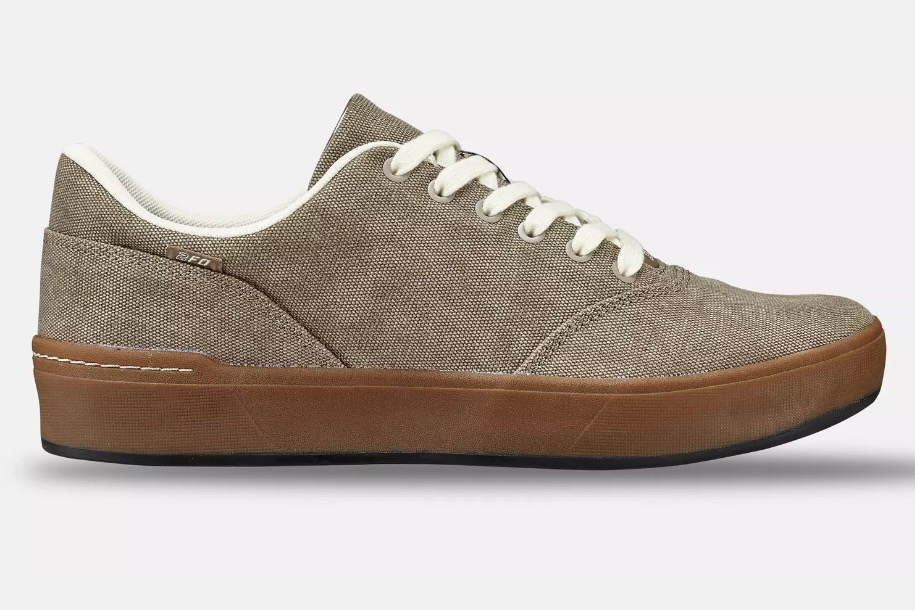
Pros
- Excellent tactile feel on the pedals
- Lightweight
- Stylish on and off the bike
- Fairly breathable
- Grips well for intended use (light trail riding, pumptrack, dirt jumps, having fun on bikes)
- Minimal branding – casual style
Cons
- Minimal foot protection
- Soaks through easily on wet days
- Softer sole may not work for everyone

Fox Union Flat
Specs
- MSRP $150
- Measured Weight 639 grams (pair, size 7 US / 39 EU)
- Upper Material Rubbery TPU one piece welded upper
- Outsole Ultratac rubber
- Closure Laces with elastic lace retainer
- Size Tested 7 US Mens / 39 EU
- Available Sizes Whole: 37 – 47 EU, Half: 41.5 – 45.5 EU
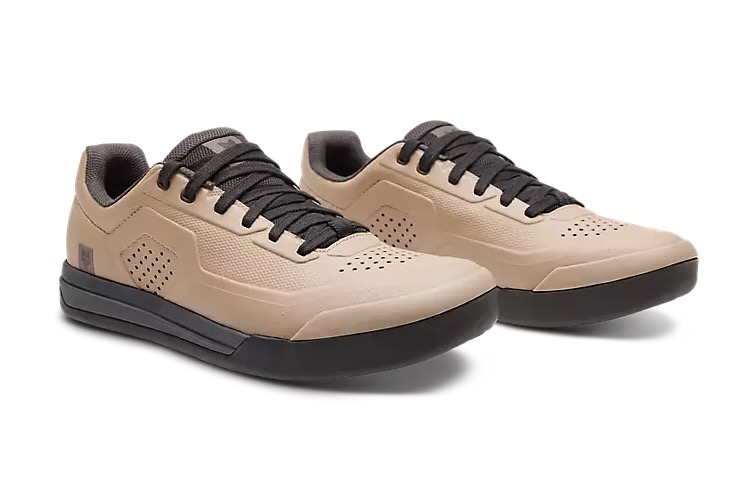
Pros
- Rubbery one piece upper is very water resistant
- Ultratac rubber sole with low profile hexagonal lugs provides solid traction in all conditions
- Precise and responsive fit
- Low stack height gives good pedal feel
- Crowd-pleasing sole stiffness
Cons
- Slightly slimmer fit might not be for everyone
- Upper can get a little hot on humid days, not the most breathable shoe
- Stock laces are pretty short
Crankbrothers Stamp Boa
Specs
- MSRP $180
- Measured Weight 664 g (pair, size 7 US / 39.5 EU)
- Upper Material Rubbery Upper (70% PU, 25% Polyester, 5% PU Film)
- Outsole Match MC2 Rubber
- Closure Boa L6, low friction wire, velcro strap at top
- Size Tested 7 US Mens / 39.5 EU
- Available Sizes Whole: 5 – 14 US, Half: 5.5 – 12.5 US
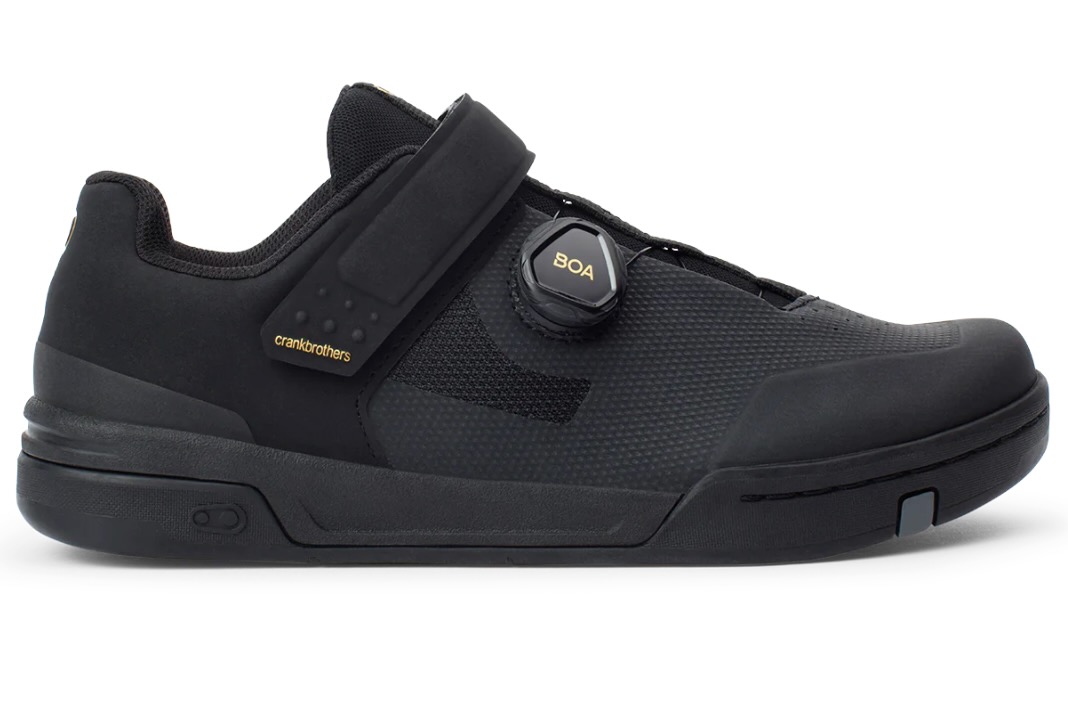
Pros
- Exceptional fit and feel on foot
- Great pedal feel from raised toe sole profile and medium flex
- Moderate breathability and great water resistance
- Solid mid-range level of protection
Cons
- Lower level of traction/grip
- More expensive
Five Ten Trailcross XT
Specs
- MSRP $160
- Measured Weight 654 grams (pair, size 7 US / 40 EU)
- Upper Material Mesh upper
- Outsole Stealth Phantom rubber
- Closure Laces with elastic lace retainer
- Size Tested US 7 Mens / 40 EU
- Available Sizes Whole: 6 – 15 US, Half: 6.5 – 12.5 US
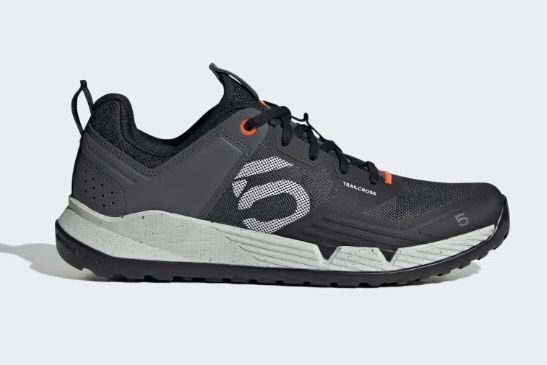
Pros
- Very open and breathable, quick drying
- Most comfortable walking shoe in the test
- Lightweight
- Good, but not great, traction on the pedals
Cons
- Good, but not great, traction on the pedals
- A little underwhelming for aggressive riding
- Very little padding and foot protection
Flat Pedal Shoes Comparison Chart
| Flat Pedal Shoe | MSRP | Measured Weight (pair) | Size Tested | Outsole |
|---|---|---|---|---|
| Giro Latch | $150 | 603 grams | 7.5 US / 40 EU | Tack rubber |
| Ride Concepts Accomplice | $130 | 643 grams | 7 US / 39.5 EU | Max Grip Rubber |
| Five Ten Freerider Pro | $160 | 627 grams | 7 US / 40 EU | Stealth S1 rubber |
| Ride Concepts Tallac Boa | $190 | 720 grams | 7 US / 39.5 EU | Max Grip rubber |
| Specialized 2FO DH Flat | $150 | 734 grams | 7.25 US / 39.5 EU | SlipNot ST rubber |
| Five Ten Trailcross GTX | $220 | 692 grams | 5 US | Stealth Phantom rubber |
| Specialized 2FO Method | $100 | 540 grams | 7.25 US / 39.5 EU | SlipNot ST rubber |
| Fox Union Flat | $150 | 639 grams | 7 US / 39 EU | Ultratac rubber |
| Crankbrothers Stamp Boa | $180 | 664 grams | 7 US / 39.5 EU | Match MC2 rubber |
| Five Ten Trailcross XT | $160 | 654 grams | 7 US / 40 EU | Stealth Phantom rubber |
Why Should You Trust Bikerumor?
At Bikerumor, we’ve been obsessing over the latest and greatest products for well over a decade. As a team of die-hard cyclists, we’re always seeking the best gear that can enhance our experience and improve our performance whether that’s bikes, wheels, tires, helmets, or footwear. Whether for personal use or reviews, we’re constantly getting our hands on the latest and greatest mountain bike shoes to put through the wringer.
For the purposes of this buyer’s guide, we gathered several of the best flat pedal shoes available in 2023 to test and compare side by side. We tapped Bikerumor contributor, Paul Clauss, for the majority of the testing which took place near his home in northern Vermont. Paul is an avid mountain biker, mountain bike coach, trail builder, and mechanical engineer. A dedicated flat pedal rider, Paul has been riding in flat pedal shoes for many years and has developed a keen sense for the performance characteristics that make a quality shoe. The punchy technical terrain of Vermont serves as an ideal testing ground with short, sharp climbs and steep, rocky, and rooty descents that will challenge the grip of any outsole compound and tread design. The wildly variable weather of northern New England also provided conditions ranging from cool to extremely hot and humid to dry and historically wet and rainy. During testing, these shoes really saw a little bit of everything.
In addition to testing flat pedal shoes, Paul has also tested the best flat pedals and the best dropper posts for comprehensive buyer’s guides. If you’re in the market for a new mountain bike helmet, we’ve tested those too. And, if you’re a clipless pedal rider, we’ve thoroughly tested and reviewed the best clipless mountain bike shoes and have recommendations for everything from XC to trail and DH riding.
Buying Advice: How to Choose Flat Pedal Shoes
With so many options on the market, choosing the right pair of flat pedal shoes can seem like a daunting task. With Five Ten dominating the market for a long time, the decision used to be a bit more straightforward, but now there are more choices than ever before to cover the needs of everyone from downhill rippers to trail riders. We suggest considering several variables when searching for flat pedal shoes; your riding style, fit/comfort, grip/traction, sole stiffness, foot protection, weather resistance, and walkability. We discuss each in greater detail below.
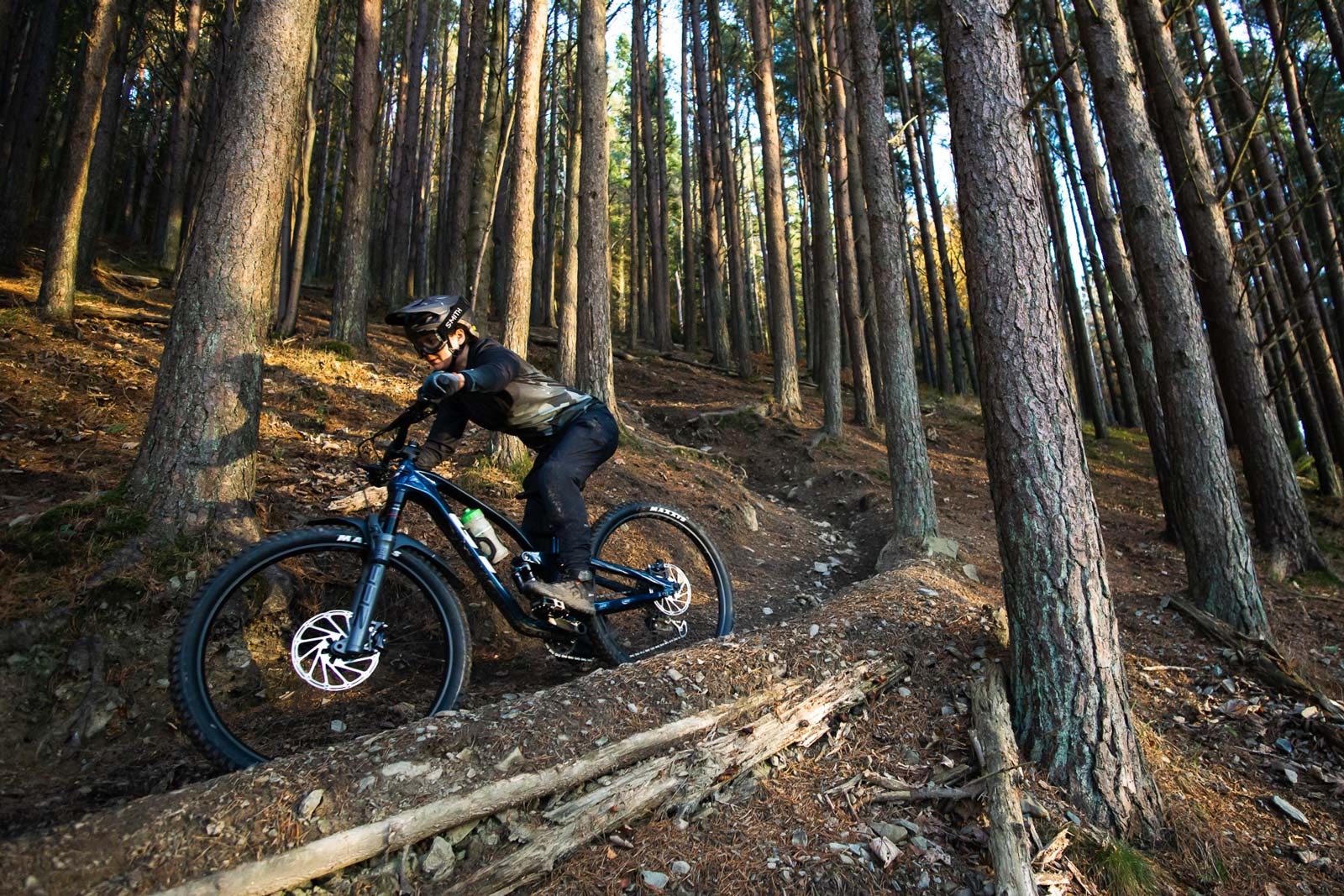
What Type of Riding Do You Do?
It may seem obvious, but the type of riding you do most often should be considered when looking for new flat pedal shoes. There are lots of different models out there designed to meet the demands of different riding styles, so one should be able to find the right shoes for the job. Downhill riders who spend their days riding chairlifts or shuttles to the top of rough, high-speed descents will often seek shoes with more supportive and protective uppers, impact-absorbing materials, and grippy soles that will keep your feet stuck on the pedals through the chatter of rock gardens and braking bumps. Trail and all-mountain riders who spend their days pedaling to the top of their descents will often steer towards a more balanced, versatile shoe that is moderately protective, pedals efficiently, provides adequate grip, and is possibly better ventilated and slightly lighter weight. People who frequent the pump track or dirt jumps tend to prefer slightly softer flexing soles for pedal feedback and often gravitate to moderately grippy soles for better foot mobility for doing tricks.
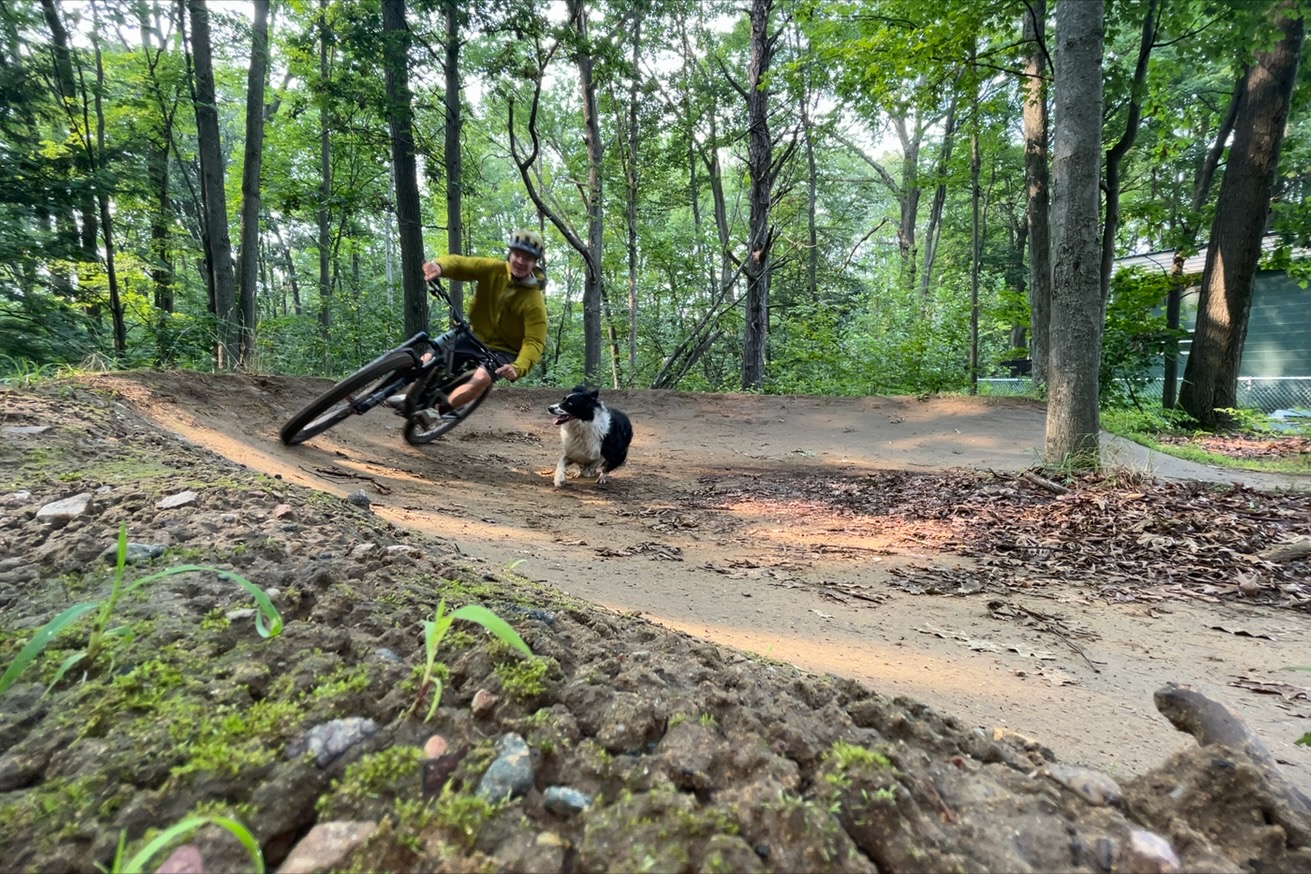
Fit and Comfort
Fit is always one of the most important considerations because it directly impacts your comfort and control of the bike. How a shoe fits is also a personal preference with some people gravitating towards a more snug and precise fit, while others may enjoy a looser and more forgiving approach. Finding the right fit for you is often best achieved by trying shoes on so you can ensure that the length, width, and volume of the shoe are right for your specific foot size and shape. This is particularly important for those with notably narrow or wide feet as most shoes are made to fit average width/volume feet.
Your regular sneaker or hiking boot size can be a good starting point although some riders size down a half size or so to get a more snug fit for foot stability and control reasons. If you already know your flat pedal shoe size, it is usually fairly consistent within the same brand, though it can vary slightly between different brands as their US and EU sizes may not line up exactly the same on their size charts. It is definitely worth referencing the size charts, and trying shoes on whenever possible.
Fit is one of the primary factors that dictates your overall comfort. Too small of a shoe and you can experience hot spots, foot cramps, or scrunched toes. Too loose and your foot may slip around inside the shoe which may result in blisters or a reduction of stability and control. Likewise, different materials, levels of padding, ventilation, and the closure system can play a role in how the shoe conforms to your foot and how comfortable it is over the course of a long ride or season of riding.
Arch support is another consideration as most brands are aiming to create a shoe that works for most people and that typically involves an insole that has an average amount of arch support. Those who have specific arch support needs will often benefit from the use of an aftermarket or custom insole to find the level they need.
The intended use of a shoe can also affect comfort. Shoes with stiffer soles prioritize pedaling efficiency and support but may sacrifice off-the-bike comfort and performance as a result. The Specialized 2FO DH Flat, for example, handles the impacts and loads of DH riding well, but isn’t super comfortable to walk in for extended periods – it’s a shoe built for downhill performance. In contrast, the Five Ten Trailcross XT is super comfortable for walking around all day, but the comparatively softer sole and less protective upper may not be the best choice for super rough downhills. Matching your riding style and terrain with a shoe’s intended use is a good recipe that should help enhance comfort based on your needs and preferences.
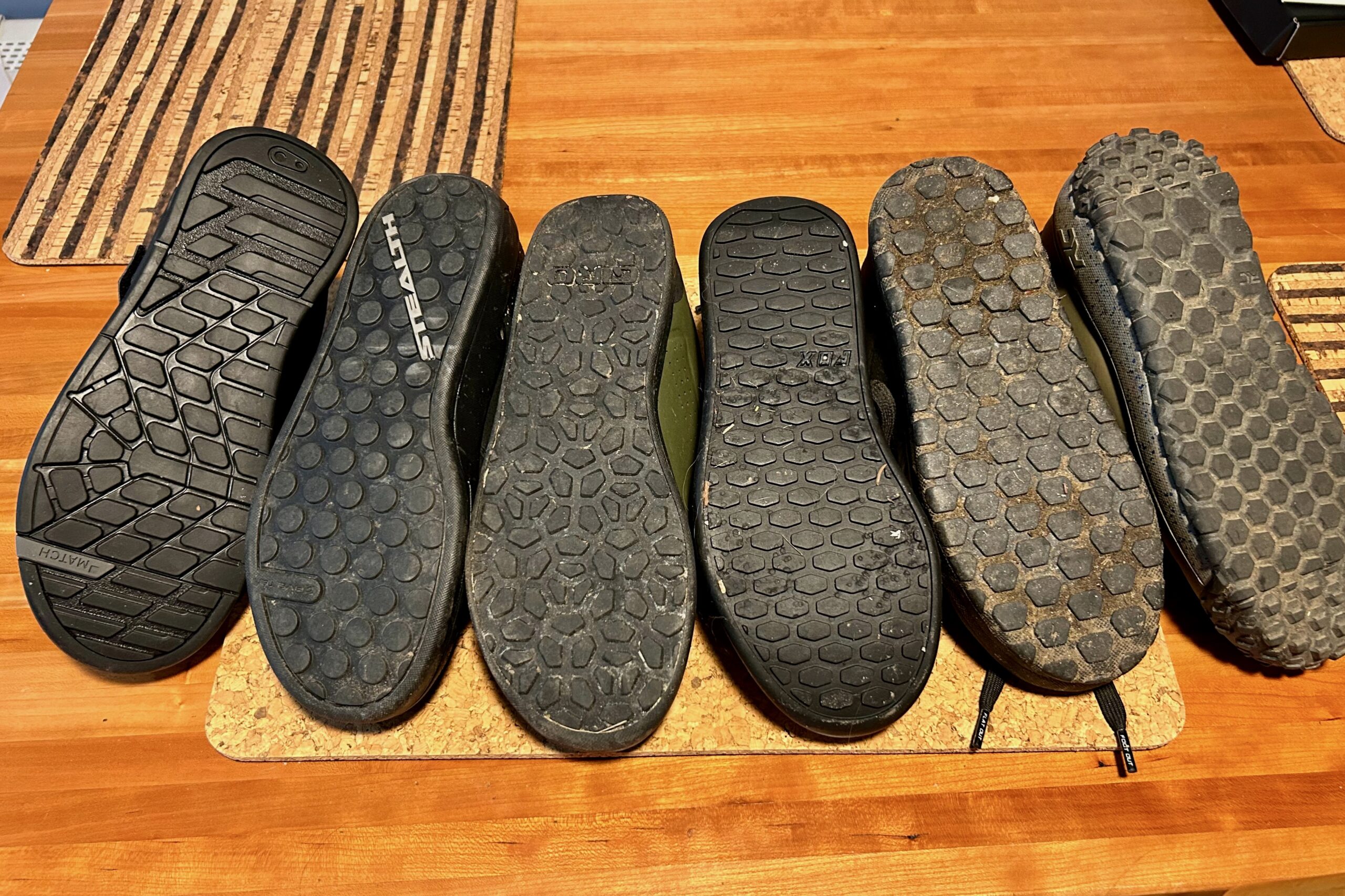
Grip and Traction
For most flat pedal riders, the grip on the pedals is one of the highest priorities, though this varies somewhat depending on riding style, terrain, and personal preferences. While many people want a locked-in, glued-to-the-pedals feel for security, control, and safety, others may enjoy a bit more freedom of movement and foot mobility. The pedal grip provided by a flat pedal shoe depends on the outsole material, tread pattern, height of the lugs, and dampening from the midsole, as well as the flat pedals you use. Most flat pedal shoes rely mainly on using soft, tacky rubber with low-profile lugs to provide a friction-based grip that the pedal pins can settle into, while others may use more of a mechanical connection approach where the pins settle into channels in the sole or against the edges of the tread lugs. The Crankbrothers Stamp Boa, for example, aims to combine friction with mechanical grip by patterning their sole pattern after the footprint of their Stamp pedals.
Only a few years ago, Five Ten’s Stealth rubber compounds were dominant in the grip department and are the reason their shoes were and continue to be some of the most popular on the market. Five Ten’s Stealth rubber is still a great choice, but thankfully, other companies’ outsoles are catching up and providing competitive levels of grip. These days, Giro’s Tack rubber, Ride Concepts’ Max Grip, and Fox’s Ultratac outsoles provide a very similar level of grip and traction on the pedals to Five Ten’s Stealth S1 while Specialized’s SlipNot ST felt the grippiest when tested side by side.
In terms of pure grip and the feeling of being truly stuck to the pedals, the Specialized 2FO DH Flat and its SlipNot ST outsole were just a cut above the rest. Just a hair below, the Fox Ultratrac, Ride Concepts Max Grip, Five Ten Stealth S1, and Giro Tack compounds provide a very balanced feel with super reliable traction and a bit more forgiveness in regard to foot repositioning. Again, the pedals you choose are a major factor in the grip equation as well, and you can check out our review of the best flat pedals if you’re looking for a new pair.
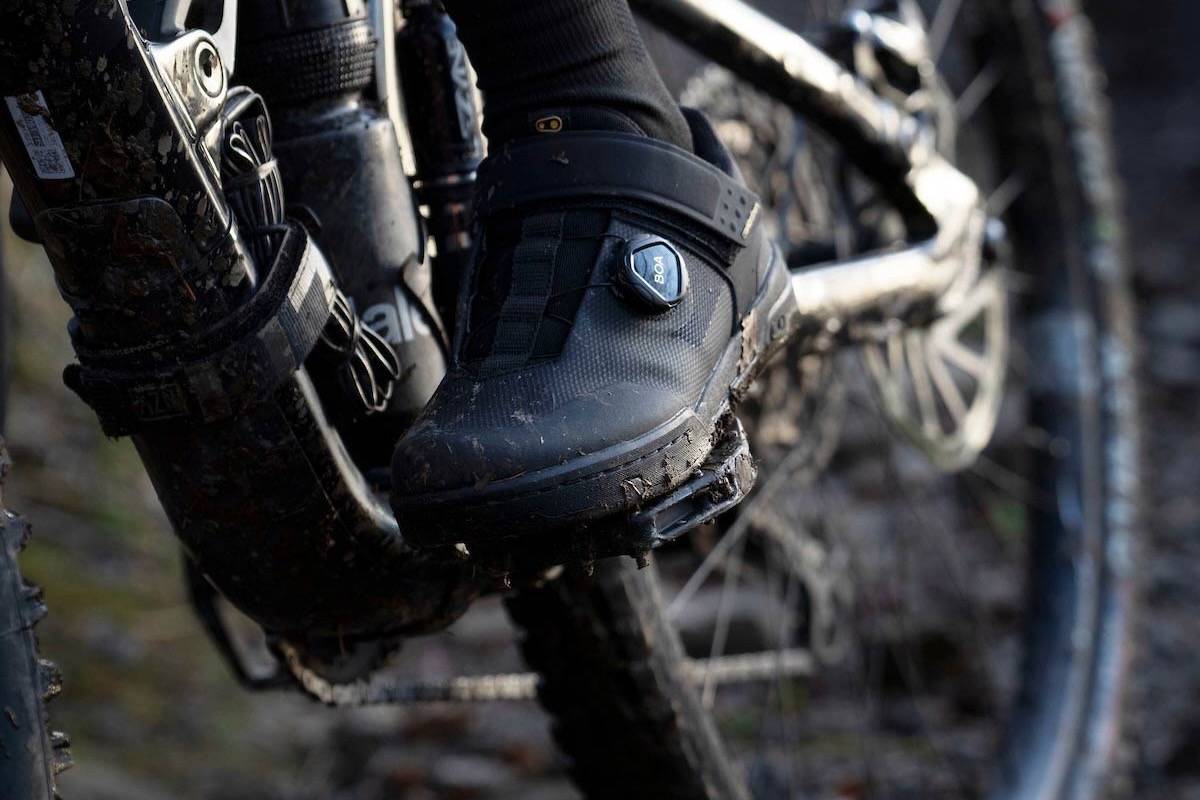
Sole Stiffness
The stiffness of the sole of a flat pedal shoe impacts pedaling efficiency, the support and feel of the shoe when riding, and how the shoe performs when walking. A stiff shoe will be slightly more efficient on long pedal-heavy rides and more supportive on long or rough descents, while a softer shoe will typically provide a more tactile feel on the pedals but less support, which can lead to foot fatigue or soreness over time. Most shoes strike a good balance with some outliers on either end of the sole stiffness spectrum designed to meet more specific needs. Like most other things, this is generally a personal preference based on the type of riding you do and the desired performance characteristics you seek from your shoes.
Given their long-standing popularity in the market, the Five Ten Freerider Pro is a bit of a benchmark that many people may already be familiar with. After riding a variety of shoes, we found the Freerider Pro to be about average in terms of sole stiffness with a slight increase on the Giro Latch, as well as a significant increase on the Ride Concepts Tallac Boa and Specialized 2FO DH Flat. Despite their higher level of stiffness, all three of those models still have a good pedal feel that avoids feeling too wooden while providing a bit more efficiency and reducing foot fatigue on longer rides or rough descents. Still, the sweet spot for many riders will likely be the moderate stiffness of something like the Freerider Pro, Fox Union, or Ride Concepts Accomplice.
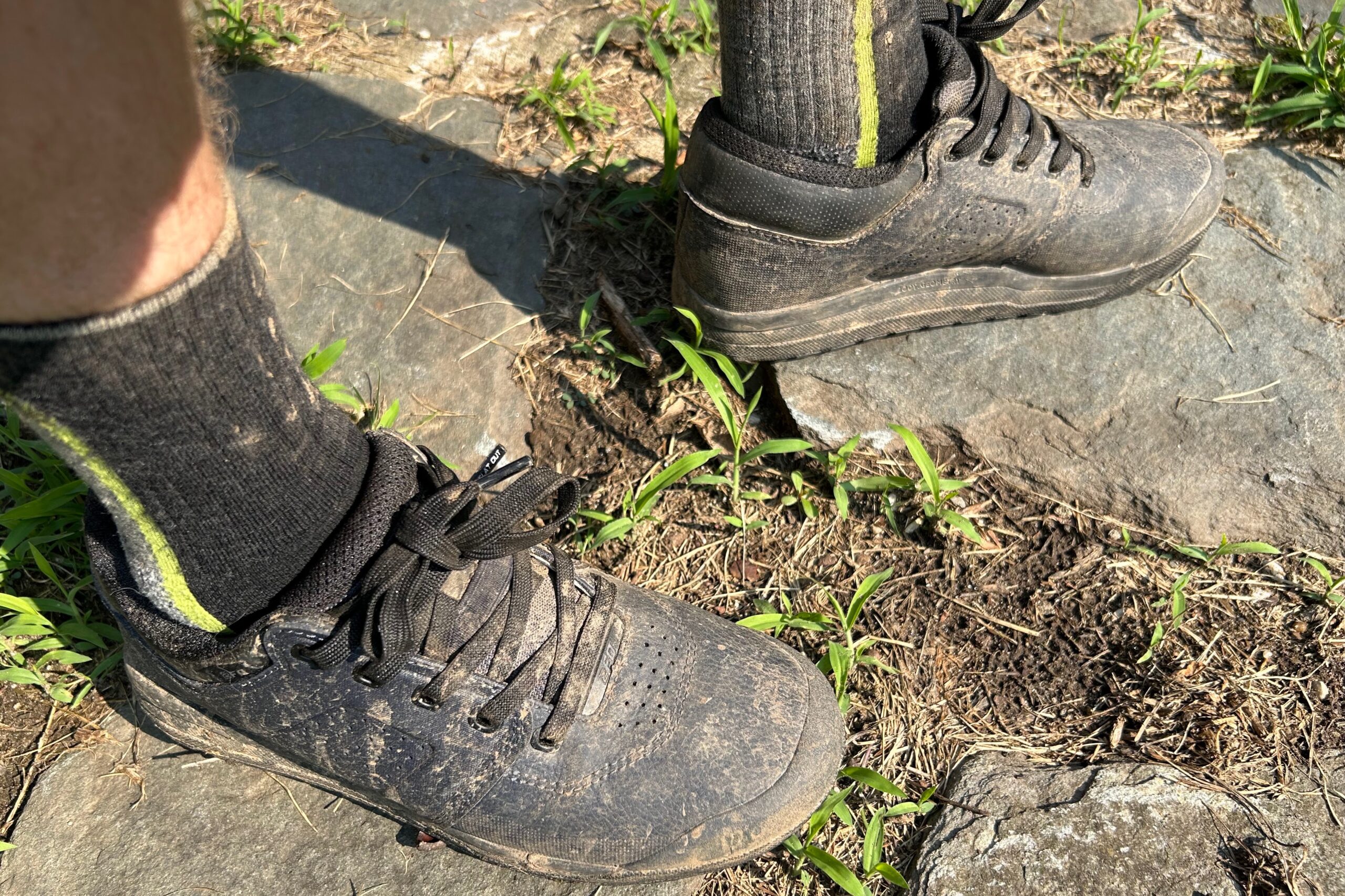
Foot Protection
The amount of foot protection to look for in a flat pedal shoe depends on what you plan to use them for. Nearly all of the shoes in this buyer’s guide have a reinforced toe box and some degree of heel/ankle padding, with the exception of the more casual Specialized 2FO Method. If you find yourself stubbing your toes frequently while riding, a larger, stronger toe box is a good choice. If you are an aggressive downhill rider, you might look for a more protective option with more padding extending through the entire shoe.
Most of the shoes we tested are versatile, all-around models that have moderate foot protection. Shoes like the Five-Ten Freerider Pro and Giro Latch look nearly identical and both have synthetic uppers, reinforced toe boxes and heels, and light padding throughout. Both the Fox Union Flat and the Crankbrothers Stamp Boa offer similar levels of reinforcement to the aforementioned models, but their rubbery TPU-coated uppers have a slightly tougher, more durable feel. All four of these shoes offer adequate protection for trail and all-mountain riding, and some people will even use them for more aggressive gravity riding too.
The most protective shoe we tested in the DH-oriented Specialized 2FO DH Flat. This burly shoe features a heavily reinforced toe box as well as a raised medial ankle cuff to provide added ankle protection. Not far behind, the Ride Concepts Tallac Boa is another burly shoe that isn’t specifically designed for DH, but should certainly be able to handle it and other aggressive riding scenarios. At the opposite end of the spectrum, the casual-looking Specialized 2FO DH Method is essentially a canvas shoe with a mountain bike sole, and it offers little in the way of protective features. Similarly, the adventure-oriented Five Ten Trailcross XT has a reinforced heel cup and lightly reinforced toe box, but the mesh uppers are otherwise quite thin and less protective than thicker materials.
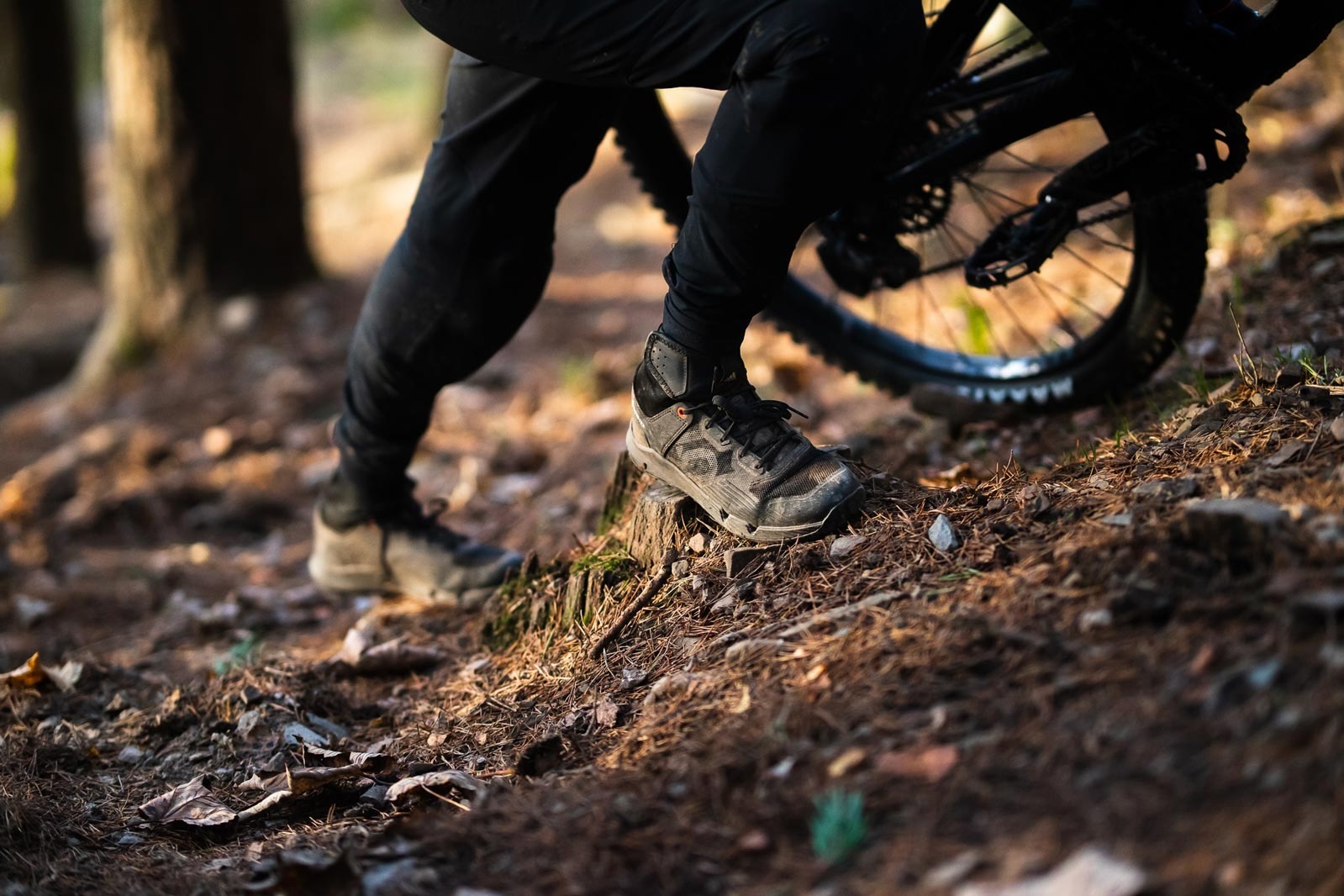
Walkability
As with the other flat pedal shoe considerations, the walkability of a pair of mountain bike shoes will vary in importance depending on your needs. Many people ride less technical trails that do not require frequent dismounts, while others may face technical rocks gardens, significant hike-a-bike sections, or like to session features regularly. Most shoes are designed with on-the-bike performance as their priority with their walkability as a complete afterthought, though some shoes aim to perform well off the bike too. You can generally tell which shoes are best for walking by looking at them – they look like light hiking/running shoes or hiking boots.
Of the shoes tested, we found the Five Ten Trailcross XT, Trailcross GTX, and Ride Concepts Tallac Boa the best for hiking, with the softer Trailcross XT better for short distances and the stiffer sole of the Tallac Boa more supportive for more technical terrain. The other shoes were fairly similar for walking with their flat soles, lower profile treads, and relatively traditional flat pedal shoe forms. They all work well enough to walk relatively normally, but you wouldn’t go out of your way to walk around in them for too long. Still, they will all get you out to that viewpoint or back up the trail to try that tricky section again with little to complain about.
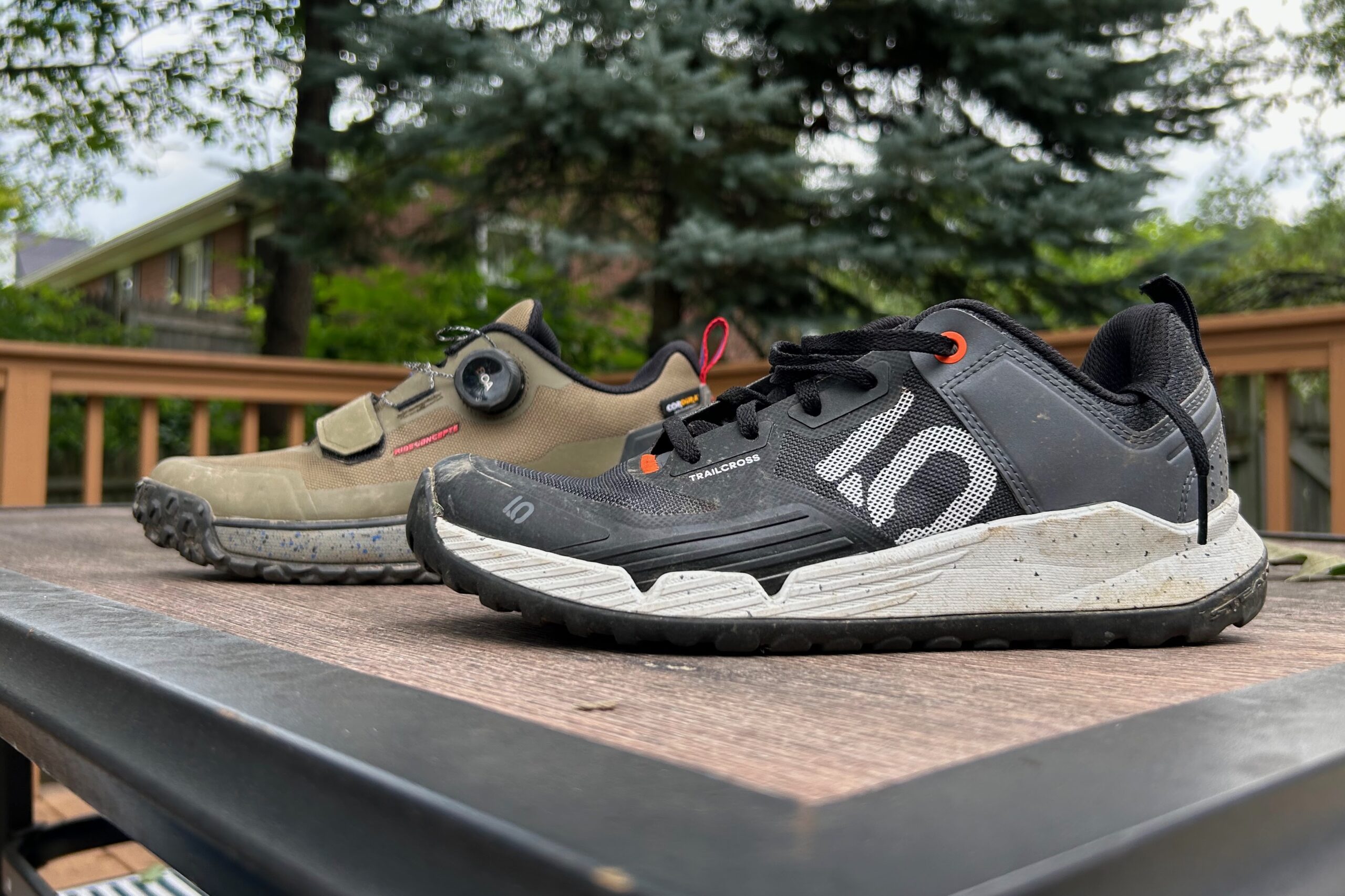
Breathability and Water Resistance
Flat pedal mountain bike shoes need to handle a wide range of temperatures and conditions from bone dry to rainy and sopping wet. Your needs, however, will depend on where you live and the conditions you experience on the trails. If you live in a very hot climate, you might compromise on the level of padding and water resistance in favor of a thinner, more breathable upper to let airflow into the shoe. If you are constantly riding in the rain, you might prefer a less porous upper with water-resistant materials to keep water out, often at the expense of breathability. Most modern shoes handle conditions from dry to light rain just fine, and there are wet weather-specific shoes, like the Five Ten Trailcross GTX with a Gore-Tex membrane, on the market for those who live and ride in the worst of conditions.
Most of the shoes tested for this buyer’s guide do fairly well across all environmental conditions, but each has its strengths and weaknesses. All-rounders like the Giro Latch or Five Ten Freerider Pro, using microfiber/synthetic uppers, stay reasonably cool and dry but are not ideal for the hottest or wettest rides. The rubbery uppers on the Fox Union and Crankbrothers Stamp Boa or the leather/textile Specialized 2FO DH Flat resist water surprisingly effectively, but trap a little more heat inside the shoe. The Five Ten Trailcross XT’s mesh upper lets air and water right in but dries very quickly. The Cordura upper of the Ride Concepts Tallac Boa proved to be a surprise favorite in this regard, balancing a high degree of water resistance while also having a well-ventilated feel. The Five Ten Trailcross GTX is a clear standout for wet conditions with its waterproof Gore-Tex membrane, though it’s designed for use in cool, wet weather, and can be a bit stifling on the feet in warmer conditions
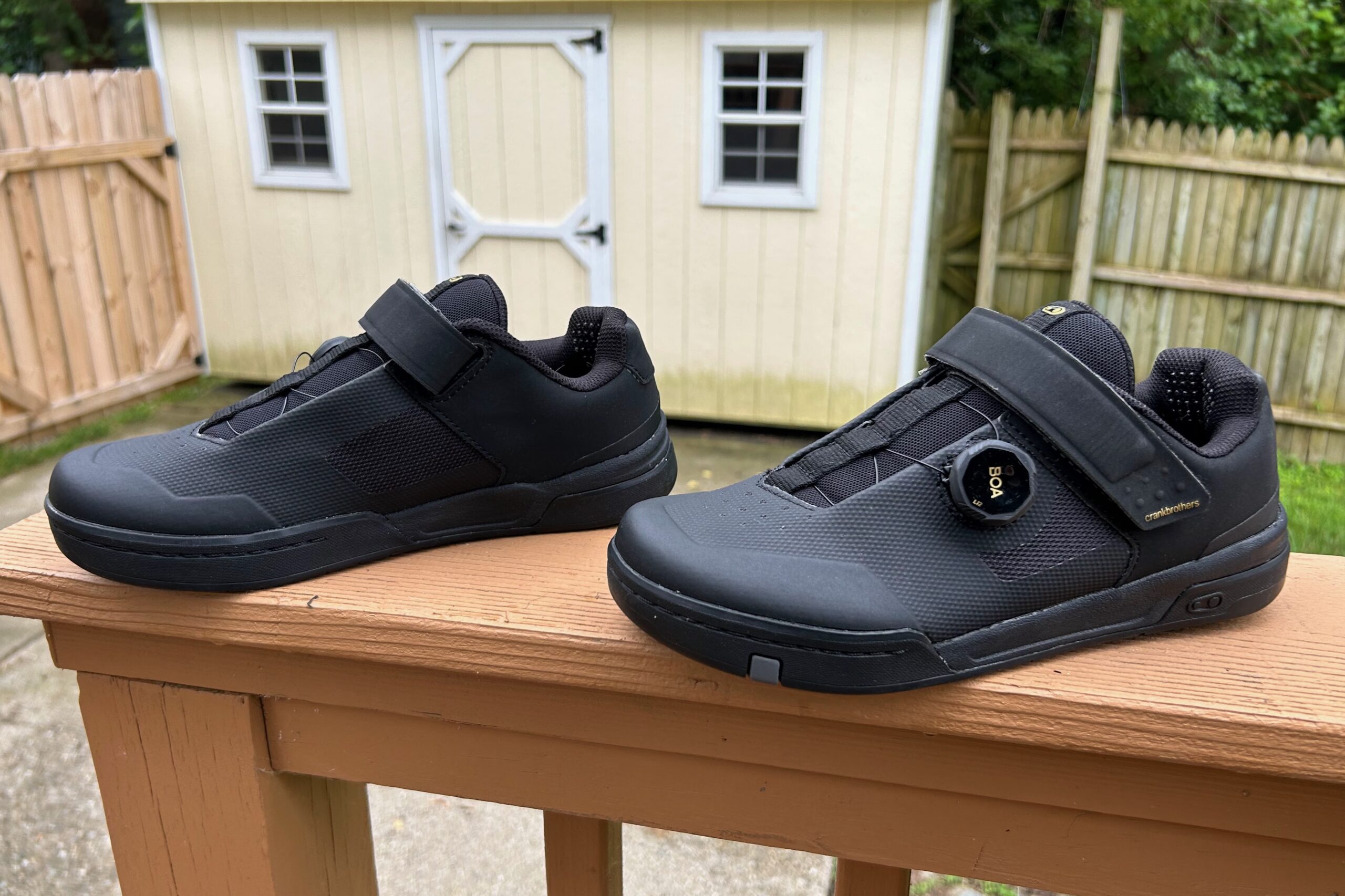
Closures
The majority of flat pedal shoes use traditional shoe laces as the closure system. This is in contrast to the clipless shoe market where there is a wider range of closure systems. Lately, however, flat pedal shoe brands have been adopting other methods for tightening your flat pedal shoes including Boa dials. Some brands and models of shoes are even offered in multiple versions, like the Ride Concepts Tallac that comes with Boa ($190) or laces ($160), and the Crankbrothers Stamp that comes in Boa ($180), Speed Lace ($150), and Lace ($130) versions to suit varying preferences.
Laces certainly work well for the flat pedal shoe application as they pull tension evenly over the mid-foot and they are cheap and easy to replace if they become damaged. The downsides are that they are a little slower to put on and take off, it takes a little longer to adjust tension while riding, and they can be messy to deal with in sloppy conditions.
Boa dials, often used in combination with velcro straps, are becoming more common on high-end flat pedal shoes. Boa systems use a ratcheting dial to add or remove tension from thin wires/laces over the foot. Boa systems make it very quick and easy to put shoes on and take them off, and to adjust tension while riding. The downsides are that they typically add to the price of shoes, they can sometimes be damaged, and have a somewhat checkered history in terms of reliability. The good news is that Boa systems are becoming more reliable and they are often covered by warranty if they break or are damaged.
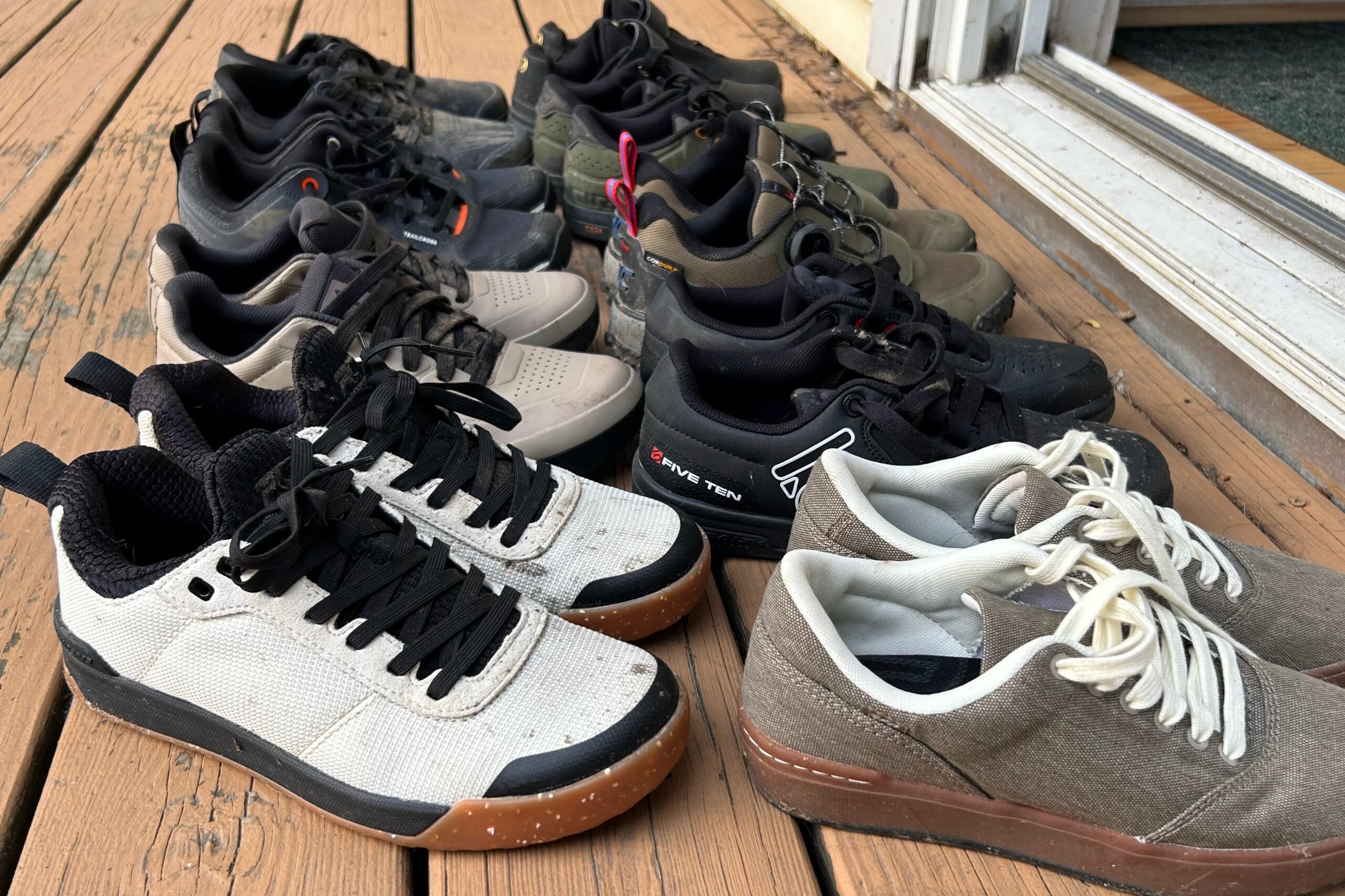
Flat Pedals
As mentioned previously, the flat pedals you choose will also play a major role in the grip, stability, and control equation. There are loads of flat pedal options on the market with different size platforms, profiles, and pin layouts that offer varying levels of grip and performance to meet different needs and preferences. While they may all look relatively similar, they most definitely are not, and we’d encourage anyone seeking a new pair to check out our comprehensive flat pedal buyer’s guide.
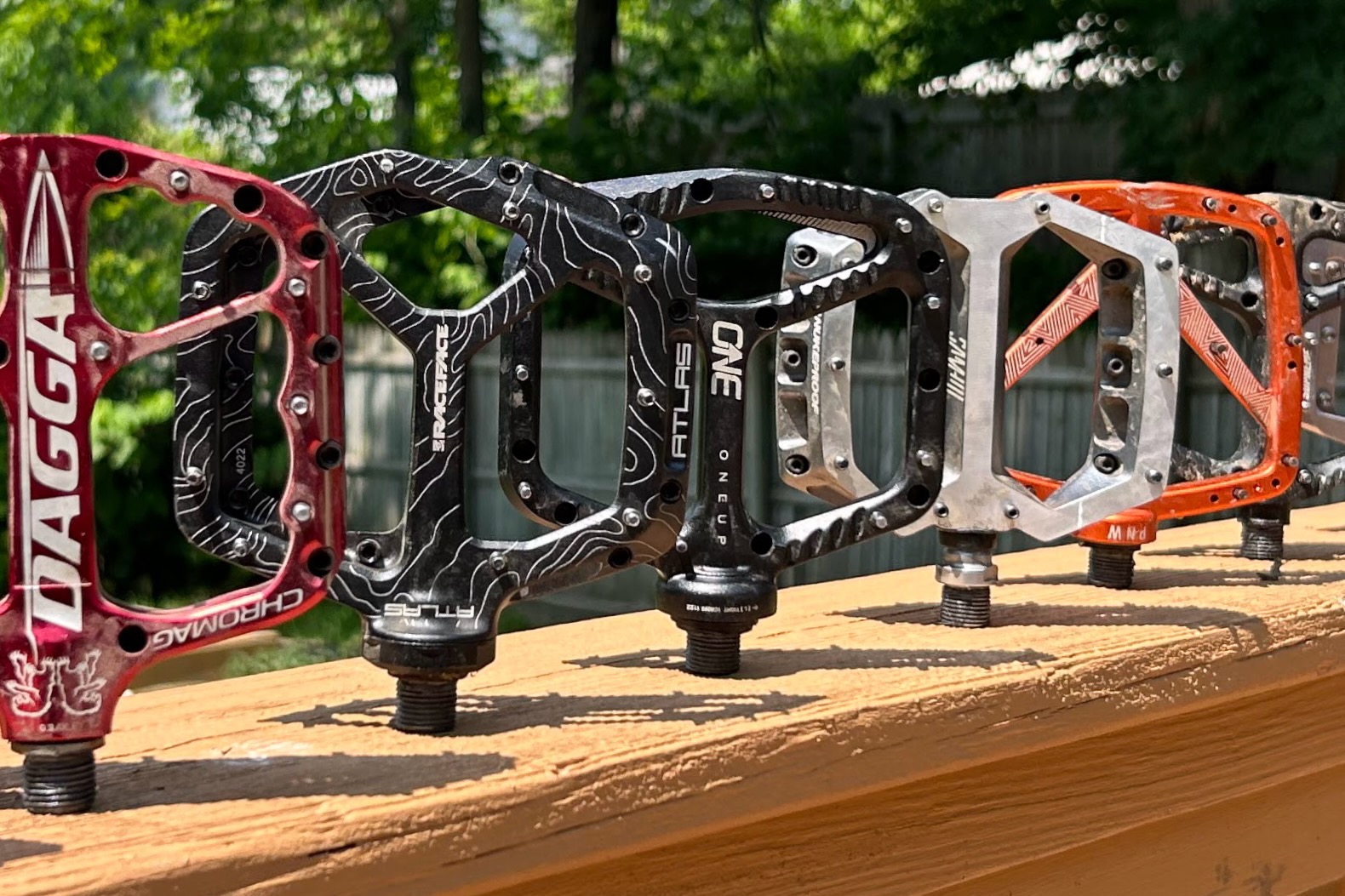
Frequently Asked Questions About Flat Pedal Shoes
Yes, of course, you can mountain bike in any old shoes you choose but we recommend using shoes that are made for the job. Flat pedal specific mountain bike shoes are optimized for traction, support, safety, and to handle the environmental conditions you’ll encounter on the trail. While preferences and opinions vary, we feel that the performance benefits, particularly pedal grip, support, vibration absorption, and foot protection, make using flat pedal mountain bike shoes the best choice.
Yes! Flat pedals vary in terms of platform size, pin layout, etc, and they provide varying levels of support and grip. Generally speaking, most good pedals will work well with most good shoes, but you’ll also need to consider your riding style and needs/wants from a pedal as they do perform differently. During testing, we used most of the shoes with the Nukeproof Horizon Pro Sam Hill Enduro pedal for consistency, with the Chromag Dagga and Raceface Atlas sprinkled in. If you’re searching for new flat pedals to complement your new shoes, we have recommendations in our flat pedal buyer’s guide.
The sole patterns on most shoes in this test are optimized to work with a wide variety of pedals, with the exception of the Crankbrothers Stamp Boa, which is designed specifically to work with their Stamp pedal line. This is done by matching the tread pattern to the silhouette and pins of the pedals. The Stamp shoes work well enough with most pedals, but we found they actually work slightly better on the Stamp pedals as the pins fit into the grooves in the sole tread.
Platform size is also a consideration, as some come in different sizes that are optimized to work with different size feet. Riders with smaller feet may opt for pedals with smaller platforms to better match the sole of their shoes, while those with larger feet will typically gravitate towards larger platforms for added stability.
The sizing of a shoe is very unique to the shape and size of your foot and proper fit is very important. Too small of a shoe and you may end up with pinched toes, cramping, and discomfort, too loose and your foot may end up slipping around inside the shoe which can cause blisters and result in a reduction of control. Fit preferences vary, of course, but most people generally can start at or near their everyday shoe size and go from there. Given that our shoes are a contact point for control of our mountain bikes, however, many people will opt for a snug fit that is achieved by sizing down slightly from their regular street shoe size. And, of course, sizing is not perfectly consistent across different brands, so it is generally best to try shoes on before you buy to ensure they fit you correctly.
The lifespan of a pair of mountain bike shoes is directly related to how much you ride and the level of abuse you put them through. People who ride almost every day all season long may only get a season of use out of a pair of shoes, while those who ride less frequently or more casually should expect to get a couple seasons or more from a quality pair. Typically, the soft rubber of the soles is one of the first places to show wear as the pedal pins leave marks, grooves, and scars in the rubber. Similarly, the uppers of shoes may be prone to damage if scraped on rocks, logs, and shrubbery, and may break down slightly more quickly when used in wet conditions frequently.
Given the duration of our test period, we can’t comment definitively on the long-term durability of any of the shoes we tested. After a couple months of riding, they all showed minimal wear and we expect most models in this test to be reasonably durable given their intended use. The beefier models like the Ride Concepts Tallac Boa, Specialized 2FO DH Flat seem the most rugged and capable of handling the most abuse, while models like the Five Ten Trailcross LT and Specialized Method couple be prone to wearing out faster given the lighter materials used in their uppers.
The post The Best Flat Pedal Shoes of 2023 appeared first on Bikerumor.

